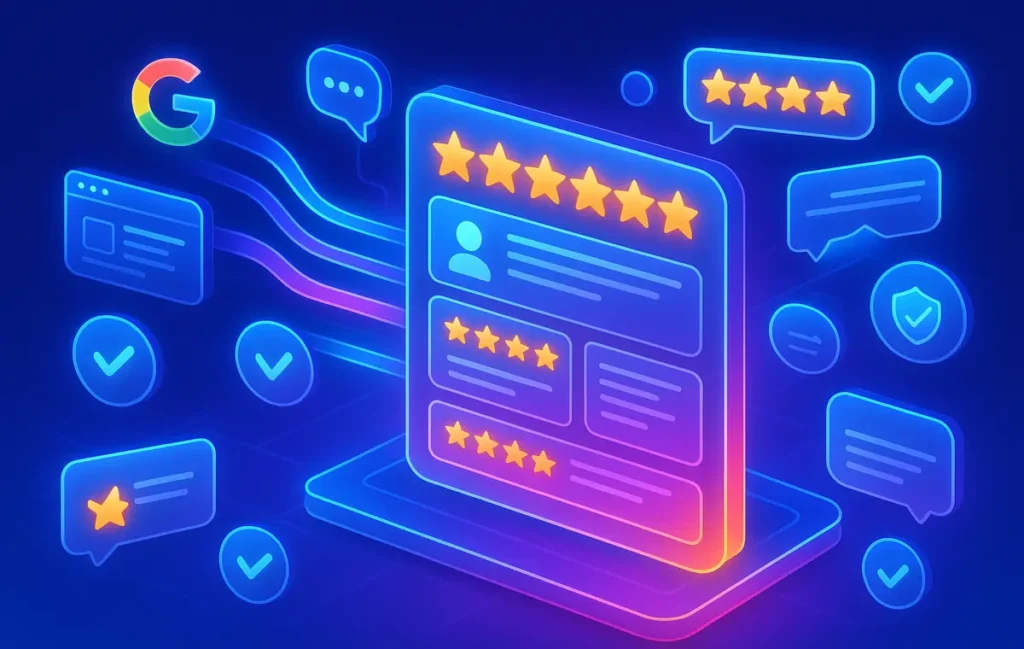🎯 Intro
Over 90% of customers read reviews before making a purchase decision. That statistic alone proves that social proof is no longer optional—it’s a prerequisite for growth. But simply having reviews isn’t enough. Brands need to collect them across multiple channels, verify authenticity, and showcase them in the right places to influence conversions.
This is where review management software steps in. More than just testimonial widgets, these platforms turn feedback into a structured asset that drives visibility, trust, and sales. If Grammarly or Adobe need polished product experiences to succeed (Grammarly Review, Adobe Creative Cloud Review), then any brand—whether e-commerce, SaaS, or local service—needs review management to build credibility and scale conversions.
🔍 What is Review Management Software?
Review management software is a category of SaaS platforms designed to help businesses systematically collect, verify, and display customer reviews across websites, e-commerce platforms, and social media.
Unlike simple testimonial widgets that only display a static quote on your site, review management tools integrate with CRMs, e-commerce systems, and social platforms to automate the entire lifecycle. They pull in reviews from multiple channels (Google, Facebook, Trustpilot), filter out suspicious ones, verify authenticity, and present them as interactive widgets, carousels, or dedicated landing pages.
In 2025, this matters more than ever. Fake reviews are rampant, consumer trust is fragile, and buyers expect transparency. Businesses that lack a structured review strategy risk being drowned out by competitors who showcase credible, verified proof.
🛠️ Core Features to Look For
The best review management tools share a core set of features that make them indispensable to marketers.
The first is multi-channel collection. Effective software automates outreach, sending review requests through email, SMS, or in-app notifications. This increases volume and reduces the awkwardness of manually asking customers.
Equally important is verification. Platforms now use AI and metadata to flag suspicious reviews. This matters because a study by BrightLocal showed that 62% of consumers lose trust if they suspect reviews are fake. Software that enforces authenticity keeps your reputation intact.
The third feature is showcasing reviews effectively. This isn’t just embedding a static list. It’s about dynamic carousels, product-specific review pages, and even video testimonials. Some platforms allow brands to turn reviews into shoppable widgets directly inside an e-commerce store.
Analytics and reporting matter too. Understanding not just the volume of reviews but the impact—for instance, how review placement affects conversion rates—helps marketers optimize strategy.
Finally, integration is key. The best platforms plug directly into CRMs, e-commerce sites, social networks, and even ad platforms, so reviews can amplify campaigns across the full customer journey.
💡 Nerd Tip: Run A/B tests on the placement of your review widgets. Case studies show that simply moving a testimonial carousel higher on the product page can lift conversions by up to 15%.
⚡ Best Review Management Platforms in 2025
By 2025, several platforms have established themselves as leaders in the review management space.
Trustpilot Business remains a gold standard, especially in Europe. Its massive network of verified reviewers gives credibility, and integrations with Google Ads allow stars to appear in paid search results, directly impacting click-through rates.
Yotpo is a powerhouse for e-commerce, offering advanced collection workflows, AI-driven sentiment analysis, and seamless integrations with Shopify, Magento, and BigCommerce. Brands like Gymshark and Steve Madden have used Yotpo to fuel their social proof strategy.
Birdeye shines for local businesses and multi-location brands. It integrates with Google Business Profiles, helping restaurants, clinics, and retailers boost visibility in local SEO.
Reviews.io appeals to SMBs with affordability and flexible review widgets. Its video review features help brands add authenticity that text alone can’t provide.
Podium specializes in review collection via SMS, making it a favorite for service-based businesses like auto shops or medical practices where email isn’t always checked.
Each of these tools has its niche, but they all contribute to one goal: turning customer voices into conversion power.
🚀 Use Cases
The power of review management software becomes clear when you examine real-world applications.
An e-commerce brand selling skincare products used Yotpo to automate review requests post-purchase. Within three months, they increased review volume by 250%, and the presence of verified reviews lifted click-through rates by 18%.
A SaaS startup used Reviews.io to collect B2B testimonials and turn them into case study widgets. These reviews became critical in building trust with enterprise buyers, shortening the sales cycle by an estimated 20%.
A local restaurant chain leveraged Birdeye to boost Google Reviews. As their average star rating improved from 3.9 to 4.5, they saw local search impressions nearly double.
The lesson is simple: reviews are not just vanity. They’re a direct lever for visibility, trust, and growth across industries.
⚠️ Challenges & Solutions
Review management isn’t without its challenges.
Fake reviews remain a persistent problem. Competitors may attempt to damage reputations, or unethical sellers might buy fake praise. The solution is using platforms with AI-driven fraud detection and moderation. Some, like Trustpilot, even offer legal support for removing defamatory reviews.
Low review volume is another issue. Customers rarely leave reviews unless prompted. Automation is key here—triggered emails or SMS after purchase increase review collection rates significantly. Incentives, like discount codes, also encourage participation while staying within ethical boundaries.
Mobile responsiveness is critical too. If your review widgets don’t display well on phones, you lose conversions. Modern platforms provide responsive designs by default, ensuring testimonials look trustworthy across all devices.
For marketers already leveraging AI video editing tools or experimenting with influencer collaborations, solving these challenges is just another part of a larger growth strategy.
📈 ROI for Marketers
The return on investment for review management software is clear.
Conversion studies consistently show that product pages with verified reviews see conversion lifts of 10–20% compared to those without. A Yotpo client reported that their average order value increased by 12% after implementing review carousels across their site.
Reviews also improve SEO. Google values user-generated content (UGC) as fresh signals, and consistent reviews can push long-tail product pages higher in rankings.
Finally, reviews amplify brand reputation. One survey found that 72% of consumers trust a business more after seeing verified reviews, making it easier for new brands to compete with established players.
At NerdChips, we’ve often noted how trust and creativity intersect. Just as a great Glide app or polished product demo matters, reviews are the ultimate proof that a product delivers.
⚡ Don’t Just Collect Reviews—Turn Them Into Conversions
Test-drive platforms like Yotpo, Trustpilot, or Birdeye. Automate collection, verify authenticity, and showcase reviews where they matter most.
🔎 Historical Context of Review Management
Before dedicated review management software existed, businesses handled social proof in fragmented ways. A small e-commerce shop might copy and paste customer feedback into a “Testimonials” page, while local businesses posted screenshots from Facebook or Yelp. The problem was scalability and credibility. As brands grew, they needed systems to track, verify, and distribute reviews across multiple channels.
The early 2010s saw the rise of networks like Trustpilot, which provided structured environments for verified customer voices. At first, this was about reputation—avoiding fake praise or malicious criticism. But over the next decade, reviews became a performance lever for marketing. Platforms realized that verified feedback could be syndicated to Google Ads, product pages, and social campaigns. In 2025, review management is no longer manual. It’s SaaS-driven, automated, and deeply connected to the marketing stack.
📊 Benchmark & Comparison Snapshot
Different platforms serve different audiences. Here’s a high-level comparison of the most widely used solutions in 2025:
| Platform | Pricing Model | Verification Strength | Integrations | Showcase Options | Best Fit |
|---|---|---|---|---|---|
| Trustpilot | Tiered subscription | Strong (verified buyer links) | Google Ads, SEO, eCommerce | Widgets, Google Seller Stars | Mid-to-large brands |
| Yotpo | Tiered, starts $29 | Advanced, AI filters | Shopify, BigCommerce, Klaviyo | Carousels, UGC galleries | D2C e-commerce |
| Birdeye | SMB-friendly tiers | Location-based checks | Google Business Profile, CRMs | Local SEO review feeds | Multi-location SMBs |
| Reviews.io | Affordable tiers | Verified purchase links | WooCommerce, Magento | Video reviews, case widgets | SMBs, SaaS startups |
| Podium | SMS-centric pricing | SMS-based auth | Local services, CRMs | Review invites, simple embeds | Service businesses |
This table shows why there is no one-size-fits-all. For example, Yotpo dominates in Shopify ecosystems, while Podium’s SMS-first strategy is perfect for service industries like healthcare or automotive.
🧩 Integration With the Marketing Stack
What makes review management powerful is its ability to integrate across the full marketing stack. Reviews don’t live in isolation—they fuel campaigns.
Consider email marketing. After a purchase, an automated email can be triggered to request a review, which then feeds directly into your CRM. With segmentation, marketers can filter promoters versus detractors and trigger different nurture paths. A happy customer might be nudged toward referral programs, while a negative review could trigger a support workflow.
Integration with ad platforms is another key driver. When Google Shopping ads show product star ratings powered by verified platforms like Trustpilot or Yotpo, click-through rates increase measurably. Social platforms like Meta now also allow embedding verified reviews in ads, turning authentic customer words into high-performing creative.
For marketers already experimenting with tools we’ve covered in NerdChips—like AI video editing software or influencer collaborations—review management is a natural extension. It ensures your campaigns don’t just rely on polished creative but are anchored by customer truth.
🏭 Enterprise & Agency Use Cases
Enterprise adoption goes beyond widgets. Large organizations use review management software for Voice of Customer analytics. By aggregating thousands of reviews, they can identify product pain points, emerging needs, and sentiment trends. Instead of relying solely on surveys, companies analyze real-time customer opinions.
Agencies also leverage review management for clients. A digital agency managing ten e-commerce brands can centralize review collection, automate requests, and deliver analytics dashboards as part of its reporting. This shifts agencies from campaign execution to strategic partners, since they’re now helping clients turn feedback into growth.
One agency case study reported that by integrating Yotpo reviews into Shopify stores and Google Ads, average client conversion rates rose 18%. This proves reviews aren’t just a reputational tool—they’re a revenue driver.
🔮 Future Roadmap & Predictions
The future of review management points toward even tighter integration with AI and real-time customer experience.
-
AI summarizers are already rolling out. Instead of scrolling through hundreds of reviews, customers see “common themes” generated by machine learning—e.g., “Most buyers loved the durability; some noted slower delivery.”
-
Crisis detection will become standard. Platforms will flag sudden spikes in negative sentiment so brands can act before issues go viral.
-
Verified badges may become regulated, similar to SSL certificates for websites, ensuring consumers can easily distinguish trustworthy reviews from fabricated ones.
-
Influencer integration will evolve. Reviews from verified creators could appear side-by-side with customer reviews, merging influencer marketing with structured social proof.
In short, review management will move from a support tool to an AI-driven, brand safety layer that every serious company needs.
📈 ROI Benchmarks & Industry Data
The ROI is not theoretical. Hard data consistently shows how review management impacts performance.
-
Product pages with 50+ verified reviews see conversion lifts of 15–20% compared to those without.
-
Google Shopping campaigns with review stars achieve 17% higher CTR than those without visible ratings.
-
B2B SaaS firms using structured case study reviews report 20% shorter sales cycles, since decision-makers trust peer validation.
One D2C brand publicly shared on X: “We thought reviews were vanity until we saw the numbers. After 200 verified Yotpo reviews, our conversion jumped 19%. ROI was instant.”
For marketers already balancing SEO, creative, and automation, review management delivers one of the clearest, most defensible ROI cases in the entire stack.
🛡 Legal & Compliance Considerations
Review management also intersects with compliance. In regions like the EU and US, regulators are tightening rules around transparency. The FTC requires disclosure if reviews are incentivized. Businesses cannot selectively hide or delete negative reviews without risk of penalties.
GDPR and similar laws also affect how review data is stored. Customer information tied to reviews must be handled with the same security and consent as any other personal data.
Best practices include:
-
Clear disclosure for incentivized reviews (e.g., “This customer received a discount for sharing honest feedback”).
-
Avoiding cherry-picking. Platforms like Trustpilot enforce balanced representation, which ironically increases trust.
-
Encrypting and securely storing review data, especially if it ties into customer profiles in your CRM.
Ignoring compliance risks both brand reputation and financial penalties. By embedding legal safeguards into review workflows, businesses can confidently scale without fear of regulatory backlash.
Want More Smart AI Tips Like This?
Join our free newsletter and get weekly insights on AI tools, no-code apps, and future tech—delivered straight to your inbox. No fluff. Just high-quality content for creators, founders, and future builders.
100% privacy. No noise. Just value-packed content tips from NerdChips.
🧠 Nerd Verdict
In 2025, review management software is not a “nice-to-have.” It’s mission-critical for any brand serious about growth. Reviews are the backbone of social proof, and managing them professionally separates trusted brands from those that fade into obscurity.
If you can collect, verify, and showcase customer voices better than your competitors, you win. In marketing, trust is currency—and review management software is how you mint it.
❓ FAQ: Nerds Ask, We Answer
💬 Would You Bite?
How many sales have slipped through your fingers because you didn’t showcase social proof?
Would you invest in review management if it meant unlocking a 15% conversion lift? 👇
Crafted by NerdChips for brands that know trust is the most powerful conversion tool.



